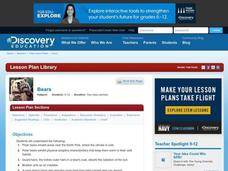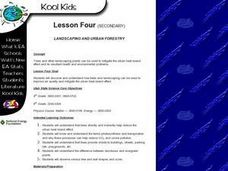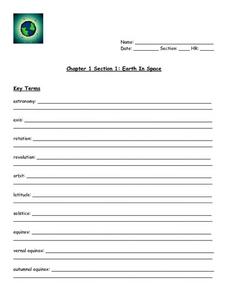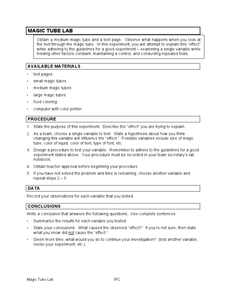Curated OER
How Tsunamis Form
In this earth science worksheet, students read and study facts about tsunami and earthquakes to complete 8 short answer questions that follow.
Curated OER
Bears
Students study polar bears and their characteristics. In this bears instructional activity students divide into groups and design a model that shows the effectiveness of their layers that keep them warm.
Curated OER
Pollution is Not a Solution
Students explore the environment by completing science worksheets in class. In this water conservation lesson, students identify ways water is used in our society and how we abuse the privilege. Students discuss methods to reduce water...
Curated OER
Sampling Rocks
Students explore Earth science by identifying types of rocks in their schoolyard. In this geology lesson, students collect a group of rocks from their playground and categorize them based on color, shape and size. Students read the book...
Curated OER
Earth's Energy Cycle: Albedo
Students complete all of the steps in the scientific inquiry process to study Earth's energy cycle; most specifically temperature and the effects of albedo (energy reflected back from Earth's surface) on temperature.
Curated OER
Program Your Partner
Students explore the world of robotics. In this robotics lesson, students study the history of robots and work with partners to find out how hard it is to accurately guide robots through simple tasks.
Curated OER
Shrinking Rainforests
In this rainforests learning exercise, students study satellite images and rainforest facts. They complete 8 short answer questions that follow.
Curated OER
Crocodiles
Middle schoolers study crocodiles and how they have survived and adapted over time. In this crocodiles lesson students research information on crocodiles.
Curated OER
Wolves: Friend or Foe?
High schoolers study wolves and their habitat in Yellowstone. In this environment and behavior lesson students create an interactive map of wolves in Yellowstone.
Curated OER
The Intertidal Zone: Tide and How Creatures Survive
Students explore oceanography by completing science worksheets. In this tide pools lesson, students discuss the forces of the tide pools, the animals that live within them, and the impact they have on the rest of the ocean. Students...
Curated OER
Landscaping And Urban Forestry - Lesson 4 (Grades 8-9)
Students discuss reasons to plant trees and the best locations for cooling. They study two homes and identify types and locations of trees and determine the placement of the central air conditioners. The class plans a landscape design...
Curated OER
Who Was Charles Darwin?
Students complete two activities to study Charles Darwin's Theory of Natural Selection. They read Darwin's journal from the voyage of the Beagle and look at the scientific ideas that influenced the development of his theory.
Curated OER
ATP PRODUCTION
Young scholars study four different types of ATP production and the important role it plays in normal everyday production, where ATP is formed. They will explore the role, functions and conditions that ATP is produced.
Curated OER
Temperature and Tracking Weather
Fourth graders discuss, describe and track weather by utilizing a variety of measurable quantities as temperature, wind speed, wind direction, cloud conditions and precipitation. They assess, through experiments and practicing, how to...
Curated OER
Recycling
Students study recycling. Group members conduct an experiment by making recycled paper over a four day period. If possible, your class will also take an excursion to a local recycling center.
National First Ladies' Library
How Do Flowers Get Their Names?
Students study Carolus Linnaeus and his classification system of plants. They examine the origin of both both common and scientific names of flowers. They speculate how their favorite flowers came to be named and brainstorm about the...
Curated OER
Earth in Space
In this reason for the days and nights on earth worksheet, students study the reasons the Earth has days and nights by answering 28 questions about earth's rotation, the equator, the relationship between the sun and moon, and the earth's...
Curated OER
HIV and AIDS: Understanding Risk Behaviors
Eighth graders research human sexuality by completing a sexual health worksheet. For this HIV lesson, 8th graders define AIDS and list the ways it can be transmitted from human to human. Students assess their own risk and complete study...
Curated OER
Mammals: Mammals and Their Ways
Students study the difference between innate and learned behaviors. They observe the adaptations and behaviors of mammals in this series of lessons.
Curated OER
Migration
Students study reasons for and examples of bird migration as a behavioral adaptation. They investigate the Bernoulli's Principles.
Curated OER
Spotlight On Stem Cells
Learners discover the differences in how stem cells develop and function depending on their source. They see how scientists are using stem cells - from a variety of sources - to study how they can be used to cure certain illnesses and...
Curated OER
The Human Eye
In this reading comprehension instructional activity, students learn about the human eye by reading a 2 page passage and studying a diagram of the eye. Students answer 8 questions, and label a diagram of the eye.
Curated OER
Magic Tube Lab
In this scientific investigation worksheet, students use "magic tubes" to make observations, hypothesize, study variables in experiments, write procedures, and draw conclusions.
National Wildlife Federation
Quantifying Land Changes Over Time Using Landsat
"Humans have become a geologic agent comparable to erosion and [volcanic] eruptions ..." Paul J. Crutzen, a Nobel Prize-winning atmospheric chemist. Using Landsat imagery, scholars create a grid showing land use type, such as urban,...























